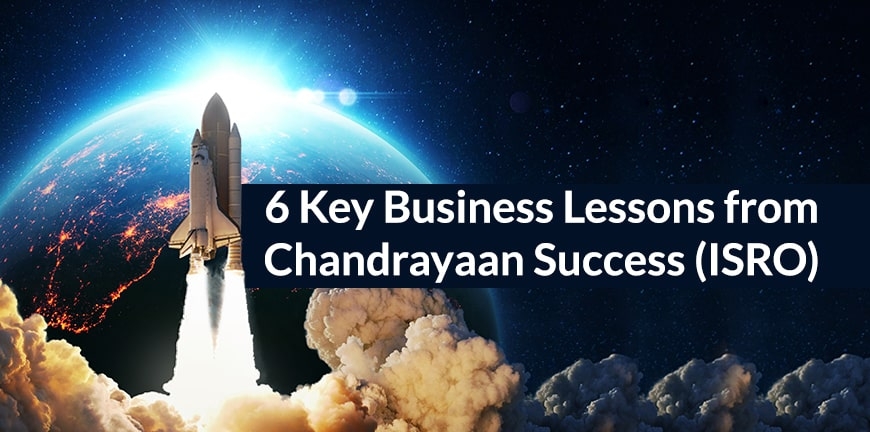
What is Apprenticeship Training?
19/07/2023
What is NATS? Definition, Benefits & Eligibility
24/07/2023Chandrayaan was India’s foray into the lunar mission space, and they have not been baby steps, but the steps of a revered giant. Discussions of how well Chandrayaan has been planned and executed, particularly Chandrayaan-3 are very popular on social media.
While Chandrayaan-2 could not achieve its objectives of a soft landing on the lunar surface because of a glitch, Chandrayaan-3 hopes to make a difference after a very successful launch. Here are six management lessons companies can learn from the Chandrayaan mission.
Every lesson is followed by an example in the corporate space of how it has been applied. Yes, these lessons are not new, but every company from startups to large enterprises would want to take notice.
1. Experiments are worth it, even with no immediate results
Did you know that all the planets in the solar system can fit into the distance between the Moon and the Earth? The moon, though a satellite of the Earth, is really far away. Mastering the distance is a gargantuan effort in itself of careful planning and execution. Similar tasks have been undertaken in the corporate space as well.
Booking.com runs nearly 1000 tests at a time and over 25,000 tests on their website landing page in a year. At a given time there are quadrillions of variations of the same landing page, which means that two customers will most likely never see the exact same landing page at a time. This was a big risk and could have affected customer conversion initially or be of no consequence, but they still did the experiment and continue to experiment.
Today they are the world’s largest accommodation and rentals platform though they were once a small Dutch startup, and this was just two decades ago. What can we learn from this? Keep running experiments in the way you work, when you stop experimenting, your teams lose focus, goal setting suffers, and work starts going dull.
2. Do not back down in the face of challenges, be patient instead
Soft landing on the moon is not easy. Earth’s atmosphere is thick enough for a spacecraft to slow down for landing due to friction. However, the Moon does not provide a similar atmosphere wherein, if not slowed down, the spacecraft might crash.
Soft-landing a lunar module means going from the roaring speeds of over 6000 km/h to zero. And this has to happen over a distance of 30 km, which is definitely a challenge.
A conventional plane has to reduce from a speed of 900 km/hr to only 240 km/hr over an altitude of 11 km. It is important to be patient in the face of such a challenge and try to embrace the results. This is exactly what ISRO has done with the Chandrayaan missions.
There’s a business example too. boAt, one of the biggest companies in the consumer audio and wearables space couldn’t get a smooth ride (pun intended), to begin with. Until 2020, they used to manufacture their products in China through third-party manufacturers, and all was well. But post Covid, when the relations between India and China soured, policies made it difficult to import goods from China.
To solve the issue, they set up a 50:50 joint venture with Dixon Technologies under the PLI scheme to manufacture boAt products in India. As the situation eases, it is believed that boAt might make a move back to manufacturing in China again. Today they continue to be a force to reckon with in the audio and wearables categories. What can we learn from this? When difficulties arise, see what viable options exist and make the best use of the regulatory shift.
3. Prepare well in a simulation before you go in for the exam
In a run up to the key Chandrayaan-3 launch, the ISRO is reported to have undertaken a 24-hour ‘launch rehearsal’ stimulating the entire launch preparation and process for this week’s Chandrayaan-3 mission to the moon.
This is another valuable management lesson, and this applies more from the point of business continuity. How soon can you bounce back in an emergency and are your teams ready for this? To achieve such a result, how many times have you trained your teams?
To illustrate this, In the corporate world, let us look at how companies manage disaster recovery. Cyber ranges from companies like Cisco help companies see how quickly they detect a vulnerability in the network and address a data breach to restore normal operations before a loss of data. Such simulations help greatly, because in 60% of the breaches, the data is stolen in a matter of hours.
Your organization needs to have a disaster recovery plan in place, and you need to test your business continuity procedures too. An example is when the cyber range is used to simulate a power failure to the databases on the back end.
Can your IT staff bring back the network, make use of back up devices and repopulate the key databases and restore everything to normalcy? A cyber range can help answer such questions in IT management.
4. Learning from the mistakes of others is key
The US soft landed on the moon in 1966 shortly after the USSR achieved it in the same year. The vehicle from the US even sent back pictures from the moon.
The US became the first country to put humans on the moon in 1969 with Apollo 11 after 31 lunar missions. India has also been trying to land a rover on the moon, and in 2008, India did a successful hard landing with Chandrayaan 1.
It did not try to take help from the US or China. In fact, the Chandrayaan too which was launched a decade after was not successful. However, Chandrayaan 3 so far has been a resounding success. This is only India’s third lunar mission.
In the business space too, this has happened in the past. Here is a great example. In the launch of the first iPhone in 2006, Steve Jobs compared the iPhone to then competitors Nokia, Blackberry and Motorola and said how the problem was in the lower half of the screen, that of accommodating all the buttons in a keypad, when a touchscreen could take all of the space and the keys could be touch-sensitive buttons.
Though some people looked at it with pessimism, the iPhone has since then sold over a billion units, an example of good learning from other’s mistakes. Apple had the courage to call a mistake a mistake and improvise from there. As an entrepreneur or organization, you should too.
5. Believe in your team for the hard stuff, self-reliance is the key to victory.
In Chandrayaan-2 the landing was tracked from a NASA-JPL station in Madrid. But for Chandrayaan-3, the complete tracking happens from the ISRO station in Bangalore, India and ISRO is self-reliant today when it comes to space exploration.
Truth be told the ISRO has far fewer failed missions than the NASA, which has spent over US$25 B (nearly 400 billion dollars or more today) on the Apollo missions alone, when the expense on most recent Chandrayaan mission was a few hundred million dollars, and was very cheap and affordable, yet successful.
There’s a reason for this. While scientists in other organizations are hired on hefty contracts temporarily, ISRO designates its permanent employees to oversee the making of the rocket, rover etc. and the entire mission thereby becomes very cheap.
The same is true in the management space when you have a strong bench, talent within your company that you can lean on during the difficult times, so retain your employees, don’t fire when you know you may need to hire again, especially the top hats! The best corporate example we have for this is ISRO itself. Can you think of anything better? Let us know in the comments below.
6. Test the waters even if you have failed in the past
Chandrayaan-3 isa great improvement on the ISRO’s previous mission, and now it also carries payload that will help “look at Earth from Moon to study its habitable planet-like features and use this information to explore exoplanets in future”. This shows us that we must not be afraid to take risks, to test the waters even if we have failed in the past.
Marvel, the comics giant that filed for bankruptcy in 1996, is a great example. This was before Marvel got into the movie arena with renewed vigour and came up with hit like Spiderman, Iron Man, Avengers and Guardians of the Galaxy. Today, with several millions in fan following and properties worth several billions, Marvel is in a League of its own (pun intended).
And none of these movies were low budget movies. In fact, most of the Marvel movies including the last Avengers were shot on a budget of several millions of dollars. The last Avengers: Endgame was shot on a budget of nearly 400 million dollars. The ISRO has a card up this sleeve in this regard. It almost always manages to conduct its operations as frugally as possible.
Closing Words
The ISRO believes that the Chandrayaan-3, the third lunar mission from India will be the jewel in its crown. What the ISRO has done with the Chandrayaan mission is the best of everything.
Where corporates have conquered only a peak or two of those we listed and have gained from it, Chandrayaan is one of a kind in the sense that it has conquered several peaks with just three missions. We hope the management lessons we learnt through Chandrayaan and the business examples we gave for each learning allows your organization to scale.




